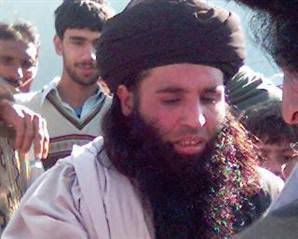Astride a white horse, sporting his trademark black turban and a black beard which engulfed the entire lower half of his face, he seemed to some at first, more of a modern day Zorro, than a deadly terrorist. But that was then. Today, the Pakistan army is at war with Fazlullah, and he is in hiding.

Maulana Fazlullah, seen in a rare new photo.
This photo is the first picture of Fazlullah that revealed a clear image of the face of one of Pakistan’s most wanted terrorists.
'Mullah Radio'
The young cleric, also known as "Mullah Radio" for his fiery anti-western, anti-Musharraf speeches broadcast from an illegal FM radio station, has developed a large following among the Pashtun tribes straddling the border areas between Pakistan and Afghanistan. (Pashtuns are an ethnic group comprising 15 percent of Pakistan’s population, mostly in the Northwest Frontier Province and in Pakistan’s southwest Balouchistan Province. They have an ancient culture, speak their own language and abide by their own tribal codes of honor and hospitality called Pashtunwali.) Most of the Pashtuns on both sides of the border would like to split from the Pakistan federation and from Afghanistan to form their own independent state.
A large majority of the Pashtuns are unhappy with what they consider U.S. influence on their tribal lands and are unhappy with the governments of both President Pervez Musharraf in Pakistan and President Hamid Karzai in Afghanistan for their support of U.S. policies in the region.
Fazlullah has had an eager audience. America was bombing them, he screamed from astride his white horse and on the airwaves of portable FM radio transponders. America was killing innocent women and children. The locals listened.
His message grew worse.
The entire valley, he said, would now be governed by Islamic laws known as Shariah. And what’s more, taking his cue from Osama bin Laden, he wanted to restore the caliphate, the Muslim dynasties that ruled the known world for centuries after the death of the Prophet Mohammed in 632 AD.
Fazlullah’s interpretation of Shariah was rigid. Most of the locals had no choice but to go along. The Swat Valley, known as the Switzerland of Asia for its breathtaking mountains, forests and lakes, was a haven for tourists. Pakistanis referred to the Valley as "just one step short of Paradise." But not any longer.
Local population terrorized
Fazlullah banned TV and music in the Swat Valley. He threatened barbers who shaved their customers’ beards and ruled that girls could not go to school. Women stayed home, too afraid to walk the streets. He then ordered his men to destroy the ancient images of Buddah, carved into the mountains of the Swat Valley -- reminiscent of when the Taliban destroyed the Buddah statues in Bamiyan, Afghanistan. The historic images were un-Islamic, Fazlullah said.
The local population was terrorized. The Taliban from the tribal areas of Pakistan and Afghanistan joined forces with Fazlullah and all sorts of foreign and unsavoury characters moved into the Swat Valley.
The Swatis, as they are known, are not particularly politically motivated; they are more business-minded, interested in commerce and trade, and of course tourism. But still they are religious, and they were afraid. They listened intently to what Fazlullah had to say. Whoever would not go along with Fazlullah’s conditions was killed. What’s more, their entire family would be killed too. Fazlullah had enlisted hundreds of young militants to fight with him. The Swatis complied; they had no choice.
The government of President Pervez Musharraf did nothing for months. The situation in Swat deteriorated by the day.
Fazlullah became emboldened. The local and foreign media screamed that the Taliban had left the border areas and moved into Swat and now held sway in the so-called "settled areas" of Pakistan. The Taliban had indeed moved into Swat, and al-Qaeda came with them.
The pressure mounted on President Musharraf and finally last November he ordered two infantry brigades of the Pakistan Army to retake the Swat Valley from Fazlullah. As of this writing, the Pakistan army now controls about 90 percent of the Swat Valley.
Rumors of demise premature
But the army still has not been able to capture or kill Fazlullah. Rumors surfaced Wednesday that he had been killed. Fazlullah, upon hearing the reports, called some local media in Peshawar, capital of the Northwest Frontier Province, saying he was alive and leading his men in the battle for the Swat Valley.
"We will continue our fight until our goals are achieved," Fazlullah said from an undisclosed location, somewhere in Paradise.










No comments:
Post a Comment